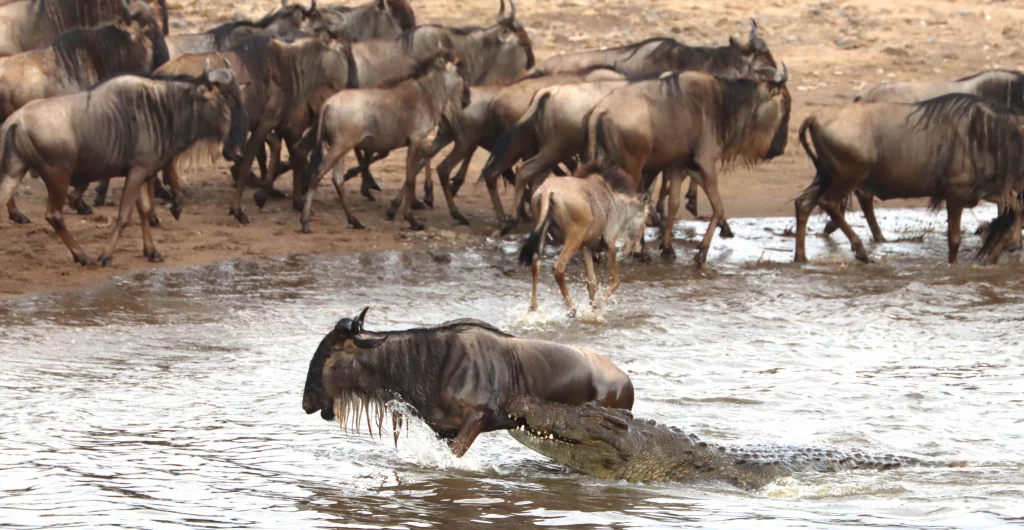The Blue Wildebeest migration is an awe-inspiring natural phenomenon that occurs in eastern Africa, particularly in Tanzania and Kenya. This remarkable event involves the movement of hundreds of thousands, and sometimes millions, of wildebeests in search of fresh grazing areas and water sources. The migration follows a circular pattern, with the wildebeests moving between the Serengeti National Park in Tanzania and the Maasai Mara National Reserve in Kenya.
The migration of Blue Wildebeests (Connochaetes taurinus) is a visually stunning spectacle, stretching for miles across the savannahs and grasslands. It is considered one of the greatest wildlife spectacles on Earth. The synchronized movements of these herbivores create a breathtaking sight as they traverse vast landscapes, facing challenges such as river crossings and predator encounters along the way.
The significance of the Blue Wildebeest migration extends beyond its visual appeal. It plays a vital role in maintaining the ecological balance of the grassland ecosystems. By grazing on older vegetation, the wildebeests stimulate the growth and regeneration of grasses, promote nutrient cycling, and prevent encroachment by shrubs and trees. Their droppings and trampling actions contribute to soil fertilization and disturbance, creating a favorable environment for plant growth and enhancing biodiversity.
The Blue Wildebeest migration serves as a reminder of the interconnectedness of species and the importance of preserving their habitats and migration routes. It is a testament to the resilience and adaptability of wildlife in the face of environmental challenges. Witnessing this extraordinary natural event firsthand is a memorable experience that highlights the wonders of nature and the need for conservation efforts to protect these magnificent creatures and their habitats.
More about the Blue Wildebeest
1. Migration Patterns:
- Blue Wildebeests are renowned for their extensive migrations, often referred to as one of the greatest wildlife spectacles on Earth.
- These migratory movements are driven by the search for fresh grazing areas and water sources, which are essential for their survival.
- The migration routes of Blue Wildebeests are determined by the availability of food, water, and favorable environmental conditions.
2. Seasonal Movements:
- The timing and direction of Blue Wildebeest migrations vary depending on the region and local climatic patterns.
- In East Africa, particularly in Tanzania and Kenya, the migration is commonly associated with the movement of millions of wildebeests along with zebras and other herbivores.
- The migration in this region follows a circular pattern, with the wildebeests moving between the Serengeti National Park in Tanzania and the Maasai Mara National Reserve in Kenya in search of fresh grass.
3. Magnitude and Numbers:
- The Blue Wildebeest migration is a massive spectacle involving hundreds of thousands, and in some cases, even millions of wildebeests.
- Their synchronized movements, often stretching for miles, create an awe-inspiring sight as they traverse across vast landscapes.
- This extraordinary gathering of wildebeests is not only visually stunning but also serves as a crucial event in maintaining the ecological balance of the grassland ecosystems they inhabit.
4. Challenges and Obstacles:
- The migration of Blue Wildebeests is not without challenges and obstacles. They encounter natural barriers such as rivers, steep slopes, and predators during their journey.
- One of the most iconic and treacherous river crossings occurs when wildebeests attempt to cross the Mara River in East Africa, where they face the lurking danger of crocodiles and strong currents.
5. Significance to Ecosystems:
- The migration of Blue Wildebeests has profound ecological implications. Their movements help stimulate the growth and regeneration of grasses by grazing on older vegetation, promoting nutrient cycling, and preventing grassland encroachment.
- Additionally, their droppings and trampling actions contribute to the fertilization and disturbance of the soil, creating a favorable environment for plant growth and enhancing biodiversity.
Understanding the intricacies of the Blue Wildebeest migration is crucial for conservation efforts and wildlife management. It highlights the interconnectedness of species and the importance of preserving their habitats and migration routes. Witnessing this extraordinary natural phenomenon is an experience that leaves a lasting impression, reminding us of the resilience and adaptability of wildlife in the face of environmental challenges.
Note: To learn more about Blue Wildebeest migration and witness this incredible event, consider visiting national parks and reserves in Tanzania and Kenya, such as Serengeti National Park and Maasai Mara National Reserve. These protected areas offer opportunities for wildlife safaris and guided tours to observe the migration up close.
![]()


Comments